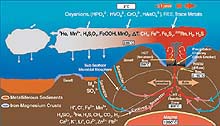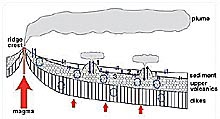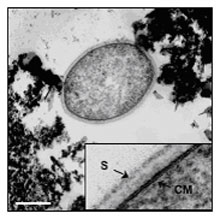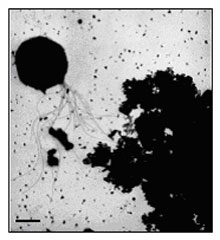
Volcanic heat at the mid-ocean ridge axis drives hydrothermal circulation and chemical exchange between the ocean crust and seawater. Microbes are known to harness chemical energy from this volcanic system at temperatures as high as 121°C. A mid-ocean ridge hydrothermal system, plume, and resulting deposits and precipitates are featured. Click image for larger view and more details.
Hydrothermal Vents, Ocean Chemistry and Extreme Microbes
David A. Butterfield
Joint Institute for the Study of the Atmosphere and Ocean
University of Washington
Pacific Marine Environmental Laboratory, NOAA
Context of Hydrothermal Venting in the Chemical Balance of the Earth
The oceans are the largest reservoir of water on Earth, and the interactions between the Sun, the solid Earth, the atmosphere and the oceans are important in maintaining the chemical and thermal balance that supports life on our planet. The Sun drives the patterns of evaporation and winds that generate rain and snowfall. Precipitation reacts chemically with rocks and soils, and transports solutes (dissolved substances) in streams and rivers into the ocean. The delivery of dissolved solutes to the ocean via rivers is the primary input to the oceans that we are all familiar with.
The ocean crust is created by the largest volcanic feature on the planet, the mid-ocean ridges. Along these volcanic ridges lies a hidden, but equally important, cycle of water transport that plays a key role in maintaining the chemical composition of the oceans. Volcanic heat drives convection of seawater through the permeable ocean crust, and the reactions that occur during this circulation remove some elements from seawater and add others (see illustration above). On a global scale, some elements' removal from or addition to seawater via hydrothermal circulation is of equal magnitude to their input from river sources.
Many metals are enriched in hydrothermal fluids by a thousand to a million times over their concentration in normal seawater. Primordial helium (the stable isotope 3He), present at the formation of the Earth, continues to leak out of the Earth’s mantle at mid-ocean ridge hydrothermal vents, and eventually enters the atmosphere when deep water wells up to the surface. Elements enriched in hydrothermal fluids are delivered to the ocean at hot or warm vents, and the effluent can be tracked by sensitive measurements, in some cases for hundreds to thousands of kilometers from the hydrothermal sources.

Cross-section of ocean crust, with volcanic ridge axis at left, and progressively older crust to the right. Large arrows represent the flow of heat from the mantle. Small arrows represent the flow of seawater and hydrothermal fluids through the crust. Click image for larger view and more details.
The Magnitude of the Hydrothermal Chemical Exchange
Clearly, the deep ocean is too inaccessible to measure the hydrothermal chemical exchange on a global scale, so systematic patterns have to be understood in order to estimate this exchange. Perhaps the simplest way to model the global hydrothermal system is to consider the heat exchange on the mid-ocean ridge and link heat to chemical exchange. Hydrothermal circulation efficiently cools newly formed oceanic crust, and the amount of heat removed by hydrothermal fluids can be estimated by comparing real sea-floor heat flow measurements to theoretical heat flow from crust that loses heat only by conduction. Once the quantity of global hydrothermal heat loss is known, one can link the chemical exchange to it by measuring and understanding the ratios of hydrothermal components to heat. In theory, then, one can simply take the product of the global hydrothermal heat term and the excess or deficit of any hydrothermal component relative to the heat of the fluid that transports it.
What Controls Thermo-chemical Relationships?
If everything were uniform along the mid-ocean ridges through space and time, we could confidently predict thermo-chemical relationships and know the magnitude of global exchange. In reality, however, the factors that control the temperature and composition of hydrothermal fluids vary considerably in time and space. Rock composition, the presence or absence of sediments, permeability of the ocean crust, boiling and separation of vapor and liquid, the amount of time since the last volcanic eruption, and depth of the heat source all vary widely. The result is a wide range of vent temperature and fluid composition.
Studies of mid-ocean ridge vents over the past 20 years have yielded a first-order picture of the chemical systematics of high-temperature fluids, although the range of composition continues to expand with exploration. In order to understand and quantify chemical exchange, we have to measure thermo-chemical relationships across the range of geological settings. NOAA's Ocean Exploration Program provides a way to search out and characterize vents in unexplored or poorly explored environments, bringing us closer to quantifying the role of hydrothermal circulation in the global chemical balance of the oceans. Work in the western Pacific is essential to progress in this area.
Microbes in Hydrothermal Environments
Microbes are present virtually everywhere on the surface of the planet: in soil, groundwater, and throughout the oceans. Since the discovery of hydrothermal vents in the late 1970s, it has been shown that microbes are also ubiquitous in and around hot and warm sea-floor vents driven by volcanic heat. The confirmed upper temperature limit for life continues to be pushed upwards, with the current mark at 121°C based on cultured microbes from hydrothermal vents at the Endeavour segment of the Juan de Fuca ridge.
Microbes have the ability to capture energy from a huge range of chemical processes. Hydrothermal vents are an excellent place to find the diversity of microorganisms because they span such a huge range of conditions in a very confined space. Fluids range from near freezing to >400°C, from oxygen-rich bottom seawater with a pH near 8 to completely anoxic, sulfide- and metal-rich hydrothermal fluids with pH as low as 2. There is clear evidence that microbes thrive along the gradient of conditions created when seawater mixes with hot vent fluids. Researchers are still gathering the samples that can tell us how microbial communities depend on and vary with the physical, chemical, and geological environment.


Thin section photomicrographs of "Strain 121" microbe that uses ferric oxide to oxidize simple organic molecules at temperatures up to 121°C. This is the hottest microbe to be maintained in culture. Scale bars are one micron. Courtesy of Kashefi and Lovely 2003 (Science, vol. 301, p. 934). For more information, visit the NSF ![]() Web site.
Web site.
The evidence gathered from the hydrothermal plumes above the Mariana Arc submarine volcanoes in 2003 strongly suggests that we will encounter vent fluids outside the range of what has previously been observed. During ROV (remotely operated vehicle) operations in these environments in March and April 2004, we expect to find new and unique microbes. This is part of an ongoing international effort to understand the diversity of microbial life on our planet and to discover microbial capabilities and products (e.g., enzymes, antibiotics) that can benefit society and the environment.
Sign up for the Ocean Explorer E-mail Update List.



























